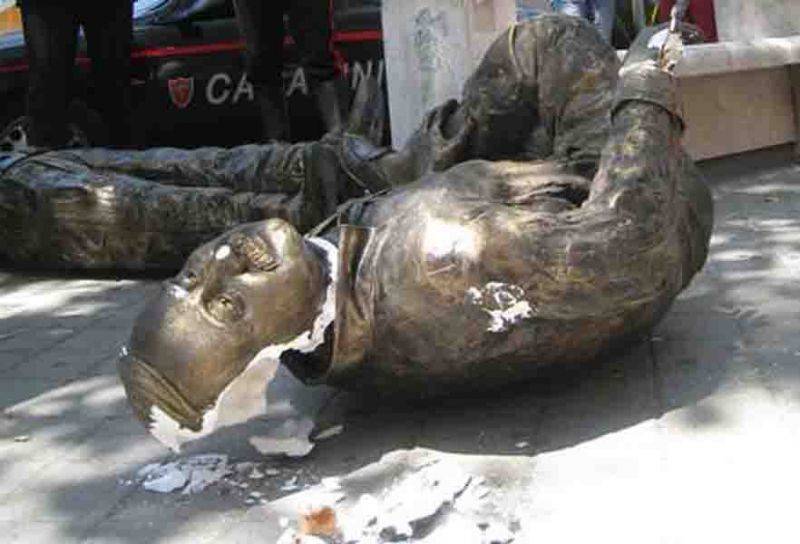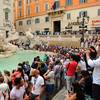Falcone and Borsellino Die Again
"Italy, how could you have let Judge Giovanni Falcone die?” In a state of shock I wrote this in May eighteen years ago for the op-ed page of the Wall Street Journal. The article was published just in time for Falcone's partner in anti-Mafia investigations, prosecutor Paolo Borsellino, to be similarly murdered by a Mafia bomb.
On Saturday both men were murdered once more, in effigy. To honor the anniversary of the murder of Borsellino on July 18, a local sculptor, Tommaso Domina, had created statues of both in plaster-of-paris, preparatory to their being cast in bronze as a permanent memorial to the two emblematic victims of the Sicilian Mafia. On Friday the statues were mounted on Palermo’s elegant main street, Viale della Libertà. At midday Saturday, before witnesses—none of whom so far has come forward—a small group of vandals smashed the statues. Elsewhere in Palermo vandals also stripped down posters announcing a candle-light march for Monday in memory of the two judges.
In April the tree on the sidewalk at the entry of the apartment building in which Falcone lived in Palermo was also vandalized, presumably by a mentally disturbed individual. The tree has become a shrine to anti-Mafia sentiment, and schoolchildren and others write letters they pin to the tree.
This Sunday, as 100,000 in Venice watched the historic regata, a scant one hundred marched in Palermo in an anti-Mafia procession, led by Borsellino’s brother.
Today, still lacking an answer to my question of eighteen years ago, I would put the question differently: why kill the judges again? Why are their statues—their memories, that is—dangerous, and precisely to whom?
A series of events shortly before and after Borsellino’s murder may eventually provide an answer. In the background was the famous maxi-trial of Mafia bosses in Palermo. The indictments written by Falcone, Borsellino and others in the so-called anti-Mafia “pool” of magistrates had resulted in 360 convictions, making that trial the most successful assault against the Mafia in Italian history, where acquittals were the rule.
Paolo Borsellino was Falcone’s fellow member in the pool. Scraps of evidence garnered this past year from a variety of sources—and not only from “repentant” mafiosi—suggest that, following Falcone’s murder, Borsellino learned that a secret service intermediary—that is, an emissary of the Italian state—was involved in negotiations with a top boss, Bernardo Provenzano. (This was not the first time a secret service connection was hypothesized; piloted leaks in June 1989 reported a secret service presence when a bomb was placed at a beach at Addaura that June 21, in a presumably intentionally failed attempt on Falcone’s life. Falcone chose to ignore this warning by the “Mafia”.)
In the alleged negotiations of 1992 and 1993, the Mafia sought more lenient treatment for its hundreds of men of (dis)honor in prison. In pursuit of this end the Mafia set off death-dealing bombs the following year in Rome, Milan and Florence.
The purported goal of the state (or of a part of the state—not all), before and after Falcone’s murder, is still unclear. One theory is that the negotiators sought an agreement to live and let live, in exchange for a reduction of violence.
But perhaps there was more. And this still ambiguous and sinister perhaps more, datable to the events of 1992 and 1993, may be what is behind the toppling of the statues and the attempts to stop the candle-light march in memory of the slain judges. Among other things, this June Palermo’s Section 2 of the Court of Appeals issued a verdict affirming that Sen. Marcello Dell’Utri, formerly a top aide to Premier Silvio Berlusconi, maintained close relations with the Mafia of Stefano Bontade and with two Mafia bosses, Totò Riina and Bernardo Provenzano, at least until the period of the murders of Falcone and Borsellino in 1992.
By this conviction, wrote Palermo journalist Salvo Palazzolo in La Repubblica of June 29, the appeals court “seems to challenge what had been considered fixed points in the latest investigations into the negotiations between the Mafia and the politicians during 1993’s season of massacres.”







































i-Italy
Facebook
Google+
This work may not be reproduced, in whole or in part, without prior written permission.
Questo lavoro non può essere riprodotto, in tutto o in parte, senza permesso scritto.